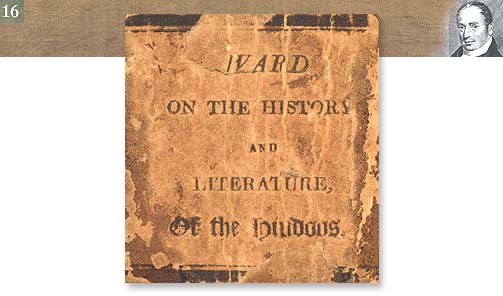

The spine label of Volume Two of an 1814, Serampore edition, of 'A View of the History, Literature and Mythology of the Hindoos', by William Ward. Courtesy Derby Local Studies Library. On 13th November, 1805, Ward had written to Stennett:
'I expect soon to put to press a work on the religion, manners, and customs of the Hindoos in Bengal. I suppose it will make a quarto volume of 500 pages; the plates will be engraved in England. I have been several years employed in it. I hope it will be of use in exposing the greatest piece of priestcraft, and the most formidable system of idolatry, that ever existed in the world.'
Towards the close of 1810, Ward published the first edition of his work on the 'History, Literature and Mythology of the Hindoos, include a minute description of their manners and customs, and translations from their principle works'. (1)
a) It opens with the Hindu account of the creation, of the divisions of the earth, and more particularly of India, and presents a brief narrative of the succession of Hindu monarchs to the advent of the Mohammedans and their rule. It then gives an account of the rise and growth in British power in Bengal derived from native sources.
b) There is then a description of the division of Hindu society into castes, with their distinguishing customs, duties and employment.
c) A large chapter is devoted to the manners and peculiarities of the different classes of society, their domestic habits and thoughts and feeling as exhibited in their conversations and correspondence. He describes the ceremonies attached to births, marriages and deaths, plus many other facts that illustrate their lives.
d) The next chapter explains Hindu philosophy as proposed by the great sages of antiquity, the civil and criminal code, and the practice of government. He then comments on their religious ceremonies, poetry, music, rhetoric and learning.
The 2nd volume explains the mythology of the Hindus, the characters and exploits of the more popular objects of worship, describes, in detail, the multiple religious ceremonies of which the Hindu's life is composed, and ends with reference to the many sects that have sprung up in Hinduism.
The work is a rich treasury of minute information collected by Ward with extraordinary patience and dedication. It continued for 50 years to be the authority on its subject.
The section on Hindu philosophy is the least successful section, as Ward did not know Sanskrit, and was therefore unable to read the original texts. He had commissioned pundits to translate extracts from the Sanskrit original into Bengali. Sanskrit specialists have since provided a better understanding of the originals but the chief value of the book is the insights it gives into the habits, thoughts and feelings of the people.
Stennett says Ward was satisfied with the reception the first edition received, and, in 1815, published a 2nd edition, abridged and improved, in 1 volume. 250 individuals, of the first rank, in the service of the East India Company raised subscriptions towards its publication. It was afterwards reprinted in England in 2 octavo volumes, and during his stay in England, in 1820, he published 2 additional volumes. In all it had occupied Ward for 20 years.
Other writers had preceeded him, particularly Sir William Jones, and Rev. Thomas Maurice; but their works, however valuable, were too elaborate and recondite for the general public. What was needed was a treatise on the Mythology of the Hindoos, which would portray its features, and correct the mistaken notion that the religion was simple, mild and virtuous. Ward's exposition is straightforward, with sufficient research, and quoted sources, to give the book authenticity.
He starts with an account of Hindu theology, followed by a description of temples, images, priests, forms and laws of worship, religious duties and ceremonies. He describes cases of the destruction of infants, the aged and dying, the immolation of widows on the funeral pile of their dead husbands, the burying of widows with their dead husbands &c. He describes their religious doctrines, their mendicant saints and the different sects. In the two (2) latter volumes there are descriptions of the antiquity of Hinduism, with research into its history, observations on Hindu civilization and its civil and criminal laws. The 3rd (2) volume describes Hindu manners and customs. The 4th (2) describes the Bengali language, contains translations from Hindu sacred books and philosophical writings and compares the Hindu philosophical system with those of Greece and others. Hindu doctrines are discussed and an account is given of their books on history, geography, &c.
An insight into the circumstances in which the book was written is provided by the erratum page at the beginning of volume one of the 1819, Serampore edition, in Derby. There are just nine errors indicated. Ward writes:
'Should the reader find other errors in this volume, in addition to those mentioned above - errors of the press he will no doubt find - the only apology the author can offer is, that the whole work has been prepared amidst an application of business which has scarcely left him, for years, a single day of entire leisure which he might exclusively devote to the necessary Translations, or to the correction of the proofs. The whole work has been accomplished by severe appropriations of remnants of time, before the commencement, or after the close, of the business of the day.'
Illustrations from an American edition of 'A View of the History, Literature and Religion of the Hindoos', by William Ward, Hartford, 1824. Courtesy Derby Local Studies Library.

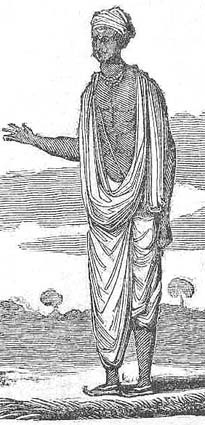
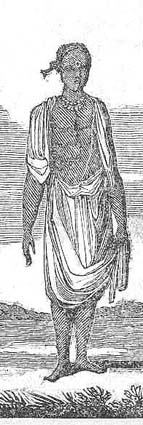
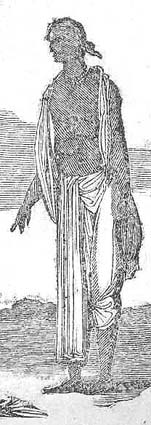
The four Castes of India, left to right: 'Brahmin, or Sacred Caste'; 'Kshutriya, or Military Caste'; 'Voisyu, or Trading Caste'; 'Sudra, or Servile Caste'.

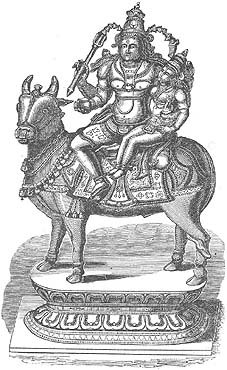
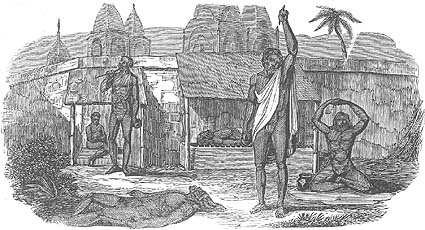
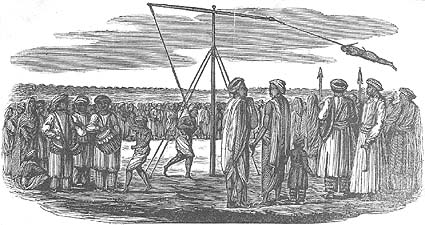
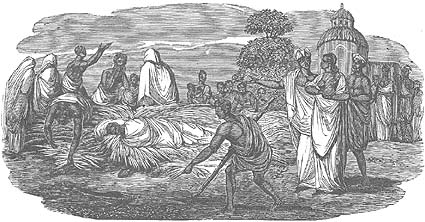
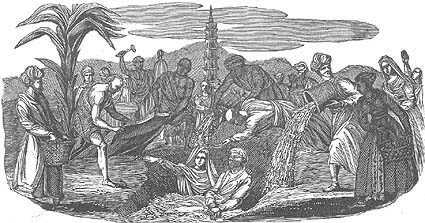
(1) John Clark Marshman previously mentioned that the first volume was 'put to press' in 1807. Stennett puts the date of first publication at 1806. Here John Clark Marshman says that the first volume was published at the close of 1810. Printing may have gone on spasmodically during the interim as Bible printing would have been the press's priority.
(2) My understanding is that the book came out in two volumes. I have seen two volumes in the Derby Local Studies Library. Later it was published as one volume.